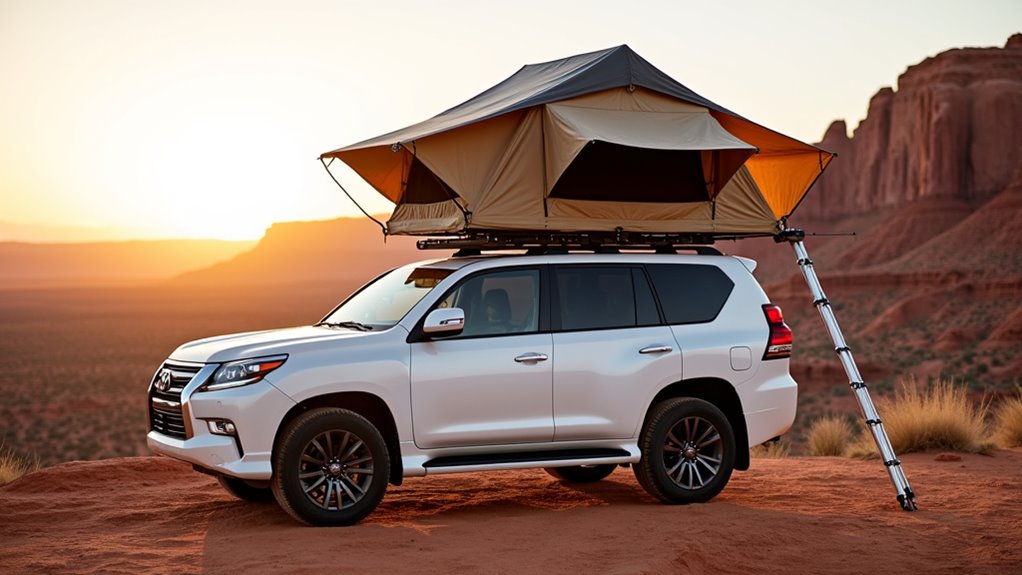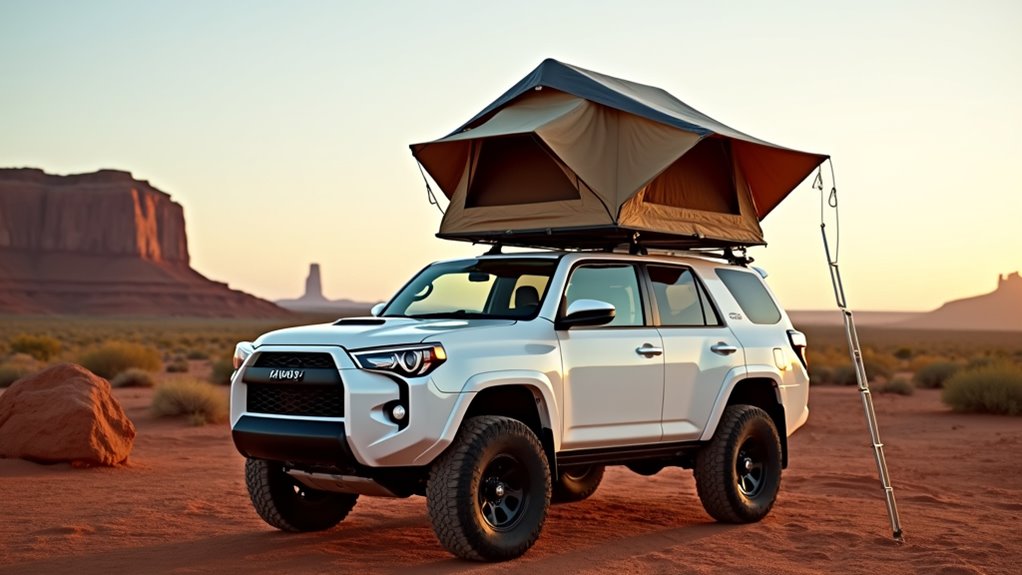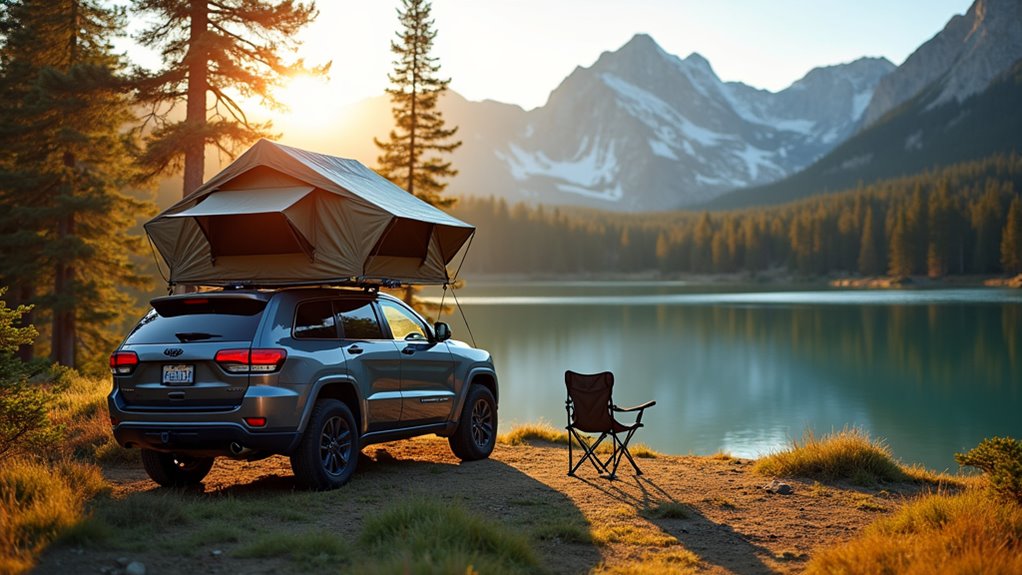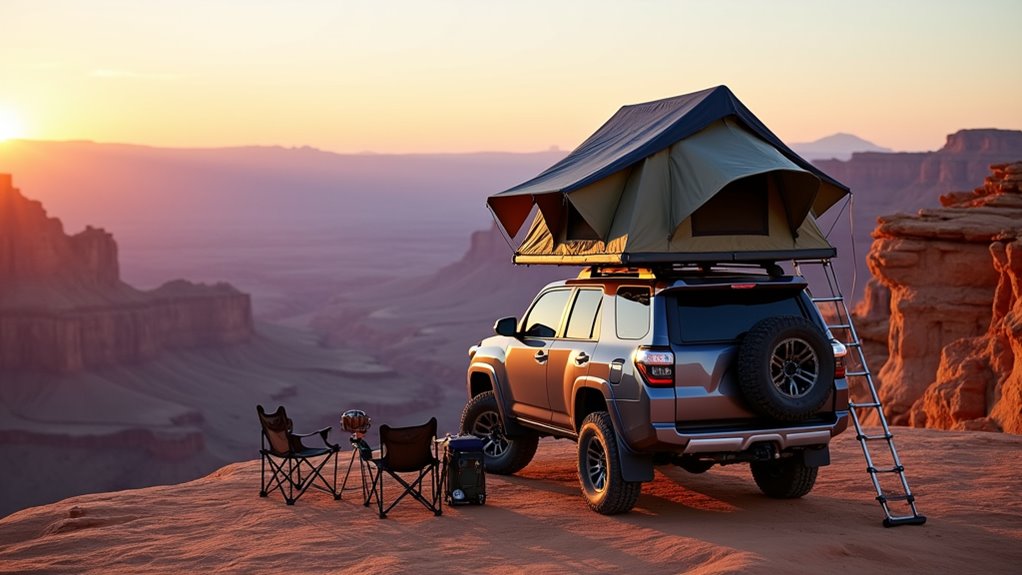Physical Address
304 North Cardinal St.
Dorchester Center, MA 02124
Physical Address
304 North Cardinal St.
Dorchester Center, MA 02124

Many campers wonder if rooftop tents are worth the investment, but the surprising truth about costs and practicality might change everything.
You’ve probably never pondered that your car’s roof could become your bedroom, but rooftop tents transform any vehicle into a mobile basecamp. These elevated shelters unfold directly above your car, eliminating the need to scout for level ground or worry about creepy crawlers. Before you dismiss them as expensive camping gear for the wealthy, there’s more to contemplate about costs, practicality, and whether they’ll actually improve your outdoor adventures or just drain your wallet.

Ever wondered how you could camp without dealing with rocky ground, wet surfaces, or creepy crawlers? A rooftop tent might be your answer. It’s fundamentally a tent that mounts directly onto your vehicle’s roof rack system, transforming your car into a mobile basecamp.
Unlike traditional ground tents, you’re sleeping several feet off the ground on a built-in mattress.
Most models fold out like a clamshell or pop up accordion-style, revealing a spacious sleeping area that typically accommodates two to four people.
Setup takes just minutes – no hunting for level ground or clearing rocks.
You’ll find two main types: hard-shell versions that look like roof boxes when closed, and soft-shell models that pack flatter but require more setup time.
When choosing a rooftop tent, consider how it aligns with low impact camping principles to minimize your environmental footprint during outdoor adventures.
Choosing between hard shell and soft shell rooftop tents comes down to how you prioritize convenience versus cost.
Your rooftop tent decision ultimately hinges on whether you’re willing to pay more for convenience or prioritize budget over ease of setup.
Hard shell tents unfold in under two minutes with minimal effort, making setup incredibly quick. They’re also more aerodynamic, which means better gas mileage. However, you’ll pay markedly more – often double or triple the price of soft shell alternatives.
Soft shell tents require more setup time and physical effort, typically taking 10-15 minutes to pitch.
They’re bulkier when closed, creating more wind resistance and reducing fuel efficiency. But here’s the trade-off: they cost much less and often provide more interior space once deployed.
If you frequently camp and value convenience, hard shells justify their premium. Budget-conscious occasional campers should consider soft shells first. When packing for any camping trip, having a well-organized hiking bag with essential items ensures you’re prepared for outdoor adventures.

Before you fall in love with any rooftop tent, you’ll need to verify your vehicle can actually handle it. Check your owner’s manual for your roof’s dynamic weight capacity – that’s the maximum weight your roof can support while driving.
Most rooftop tents weigh between 100-200 pounds, so you’ll need at least that capacity.
You’ll also need a roof rack system with crossbars. If your vehicle doesn’t have one, budget an extra $200-800 for quality racks.
The crossbars must be spaced correctly to match your tent’s mounting points, typically 24-48 inches apart.
Consider your vehicle’s height too. Adding a tent creates a tall profile that won’t fit in standard parking garages.
SUVs and trucks work best, though many cars can accommodate lighter soft-shell models.
Many camping enthusiasts who use rooftop tents also enjoy rock climbing as it allows them to set up base camp close to climbing areas without needing ground-level tent space.
While sticker prices might suggest rooftop tents are expensive toys, the real financial picture gets murky once you factor in all the extras. You’ll need a roof rack system if your vehicle doesn’t have one – that’s another $300-800. Installation costs can add $100-200 unless you’re handy with tools.
Don’t forget the hidden expenses: higher fuel consumption due to increased wind resistance, potential parking restrictions in covered garages, and storage solutions when you’re not camping. You might need a ladder for easier access, weatherproofing treatments, and replacement parts over time.
Budget $2,000-5,000 total for a quality setup with accessories. Compare this against hotel costs for your typical camping frequency – you’ll need 20-30 camping nights annually to break even financially. For perspective, experienced backpacking travelers often spend similar amounts on accommodation during extended European trips.

Despite the upfront investment, rooftop tents deliver compelling benefits that traditional camping gear can’t match.
Rooftop tents offer unmatched advantages over traditional camping gear, making the initial cost worthwhile for serious outdoor enthusiasts.
You’ll appreciate these key advantages:
You’re also gaining security from wildlife and peace of mind knowing your shelter’s always with your vehicle.
For jungle camping specifically, hammock camping offers similar elevation benefits and can be an excellent alternative in dense forest environments.
For frequent campers, these benefits often justify the higher price tag.
Though rooftop tents offer clear advantages, they come with significant limitations that’ll impact your camping experience and wallet. You’ll face reduced fuel economy due to increased wind resistance and weight on your vehicle’s roof.
The setup process isn’t as quick as advertised – expect 10-15 minutes even with practice. Storage becomes problematic when you’re not camping, as these bulky units require garage space or weatherproof covers.
You can’t easily access your vehicle once camp’s established without partially dismantling your shelter. Height restrictions will limit where you can drive, and parking garages become off-limits.
The initial investment ranges from $1,000-$4,000, plus additional costs for roof racks and installation. Weather dependency increases since you’re more exposed to wind and storms than ground-level alternatives.
Consider investing in an essential survival kit to ensure you’re prepared for unexpected situations that rooftop camping might present.

Three types of outdoor enthusiasts find rooftop tents worth the investment despite their limitations.
Despite higher costs and setup challenges, rooftop tents deliver unmatched convenience for specific camping styles and adventure preferences.
1. Frequent Car Campers Who Value Convenience
You’ll appreciate the quick 5-minute setup if you’re constantly moving between campsites. No ground prep, no rock removal, and you’re sleeping off wet or uneven terrain every night.
2. Overlanders on Extended Road Trips****
If you’re planning multi-week adventures through remote areas, rooftop tents offer consistent shelter without hotel costs. You’ll save hundreds on accommodations while accessing backcountry spots regular tents can’t handle.
3. Fair-Weather Campers with Reliable Vehicles****
You don’t need extreme off-road capability, but you want comfort above ground level. Perfect if you camp seasonally and can justify the $2,000+ investment across multiple trips yearly.
Whether you choose a rooftop tent or traditional ground camping, mastering tent camping tips will enhance your outdoor experience and help you avoid common beginner mistakes.
Before you commit thousands to a rooftop tent, several proven alternatives deliver similar benefits at a fraction of the cost. Ground tents offer flexibility and cost-effectiveness—you’re not limited to sleeping where your vehicle’s parked.
Quality backpacking tents weigh less and pack smaller than rooftop systems.
Car camping with a hatchback or SUV transforms your vehicle into sleeping quarters without additional investment. Simply fold down seats and add a mattress pad.
Truck bed tents provide elevation benefits while costing considerably less than rooftop options.
Hammock camping eliminates ground concerns entirely and weighs practically nothing.
Pop-up camper trailers offer more space and amenities, though they require towing capability.
Whatever camping setup you choose, remember there are certain essential items you should intentionally leave at home to keep your pack light and your experience enjoyable.
Consider your camping frequency, budget, and specific needs before investing in rooftop gear. These alternatives might perfectly suit your adventure style.

After weighing all options, your camping habits and priorities will determine whether a rooftop tent makes financial sense. Consider these key factors before purchasing:
Your camping frequency and honest assessment of actual usage patterns should drive the rooftop tent investment decision, not wishful thinking.
Don’t buy based on aspirational camping plans. Be honest about your actual usage patterns, storage space at home, and whether you’ll maintain the tent properly. If you’re new to outdoor adventures, mastering canoeing basics first can help you understand your true camping preferences before investing in expensive gear.
You’ll either become a rooftop tent evangelist who can’t imagine camping any other way, or you’ll realize it’s an expensive way to sleep closer to the clouds. If you’re constantly chasing remote adventures and your wallet can handle the hit, you’ll think it’s the greatest invention since sliced bread. But if you’re a casual weekend warrior, you might find yourself with a very expensive roof ornament that collects more dust than memories.